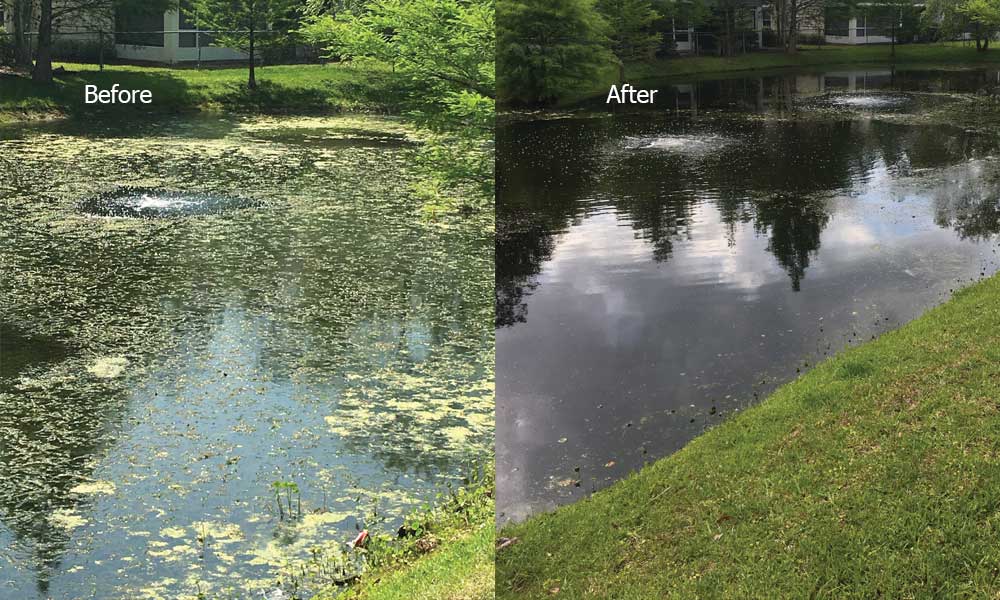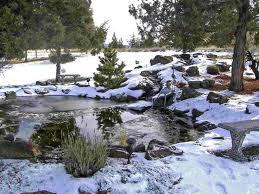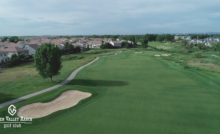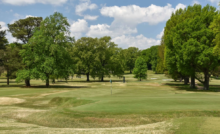A Pond’s Life


Diversified Waterscapes Before and After
As the seasons change throughout the year, all life adjusts in unique ways. Of course, the scope and magnitude of seasonal changes vary depending on the different locations and climates all over the world. Each season brings new challenges maintaining life. These seasonal rhythms affect all aspects of your pond as well. It is imperative that a pond keeper understands the maintenance adjustments as the seasons change. Every part of the ecosystem of the pond is life that must be maintained for its survival. The water, microscopic life, fish, aquatic and bordering plants must all be considered according to climate changes.
Winter Pond


Depending upon the significance of the climate change the maintenance needs of the pond will differ. In a more drastic change of season the maintenance falls to almost nothing. The fish will move to the deepest part of the pond and huddle together because the earth helps warm them. In the early Fall you should feed your fish a bit extra because they are preparing for Winter hibernation. Be sure to monitor the water temperature. A pond water thermometer is priceless for proper pond care. When the water temperature drops below 50 degrees Fahrenheit you no longer need to feed the fish. If the temperature of the pond rises above 50 degrees Fahrenheit you can feed your fish wheat germ. It is a good idea to get a floating de-icer to keep an area of the pond free of ice. DO NOT BREAK THE ICE! If you break the ice the shock waves can possibly kill your fish. Keeping your pond ice free will allow for an exchange of oxygen into the water for fish to respire and removes carbon dioxide from the pond. This balance is required for healthy fish and plants, while preventing algae blooms or acidification of your pond. Luckily, cold water holds more dissolved oxygen so algae blooms are less common in the winter.
Related: Taking an Offensive Position in Your Lake Maintenance Game
Spring Pond
In the Spring your pond water begins to warm and you see your pond coming back to life. This is an important time to pick up on the maintenance routine to prepare the water, fish and other aquatic life for warmer weather. Anything you did to prepare your pond for Winter can be undone now. Turn your pump back on if you did not have it running. It is time to start feeding your fish again. Make sure that you start out feeding them cold weather food if the water temperature is a constant 50 degrees. Once the water temperature reaches 60 degrees you can begin the full season feeding program. It is Spring and time to “garden” your pond. You should clear away all of the dead leaves and debris that have accumulated over the winter. You can use a skimmer type of net to do this and it will allow you to scoop up leaves on the bottom of the pond. There are products that will hasten the natural process of decomposition of this debris. A pond vacuum can be used to remove debris and muck from the bottom of the pond. You should use a cleaning system that does not remove much of the water. As the weather continues to warm you can add appropriate plants according to the warming process.
Summer Pond
There is something about summertime that brings out the beauty of all living things. Your pond, perfectly maintained, can be the peaceful, magical place of beauty to retreat to where the only sounds necessary are those of the water and creatures around it. The key word to make your pond that place is “maintained”. All of the aquatic life is fully awake, active and growing. The fish need to be fed between one and three times per day. Do not overfeed them. Feed the fish no more than they can eat in 5 minutes. All of the methods of maintaining a healthy pond are in full swing. With the warm weather nuisances like algae will take over if not controlled. It is important to maximize your aeration. Warm water holds less oxygen, yet the fish use more oxygen in warm water. There must be plenty of aeration going twenty four hours a day all seven days of the week to ensure lots of gas exchange. A stagnant pond in the warm summer months is a recipe for algae blooms. Not only is weed and algae control important, but pest control is at its peak in the summer. Critters from land, air and water will find their way to your pond and claim it as theirs if not controlled. The water quality is the single most important aspect of a healthy pond. Natural waters are never pure, though, because water is a powerful solvent. Water dissolves some of every gas or solid it contacts, and some of these dissolved substances affect the water’s pH. Pond water should have adequate levels of alkalinity and hardness for the species under culture, and those levels should not be widely disproportionate. The biological condition of the pond is equally vital, as it dictates the water quality. Beneficial bacteria play a key role in breaking down organic matter and cycling nutrients, while carefully chosen aquatic plants and fish contribute to the overall balance. Together, they help regulate the pond’s water quality and minimize harmful fluctuations. Filtration with sand, wetlands and the use of a bio-filter are very beneficial to water quality. Summer may be the busiest time for a pond keeper, but it can also be the most enjoyable when your pond is well maintained.
Related: Keeping Your Golf Water Features Healthy
Fall Pond
The vibrant colors of Fall are stunning. Unfortunately, those beautiful colors end up floating on top of your pond. With the temperatures beginning to drop it is time to switch to cold temperature beneficial bacteria and reduce your fish feeding regimen. With each new season comes a different method of pond maintenance. Make your life a lot easier by thinning out your aquatic plants in the Fall instead of waiting until the end of Winter! During the Winter your aquatic plants focus all of their energy on their root system mass. Your aquatic plants may turn yellow or brown as they go dormant. They are not dying. Trim back the yellow and brown to prevent debris from building in the bottom of your pond. If plant matter accumulates at the bottom of a pond, it can turn into sludge which brings harmful bacteria, unpleasant odors and reduces water depth. Those beautiful, colorful leaves that are floating on your pond will decay and release excess nutrients such as nitrogen into the water which can cause algae blooms. It is important to remove them from the pond to avoid that consequence. You can use a net to skim them off of the top of the pond as they fall. This can become a tedious daily chore. Skimmers are not designed for this much debris. Heavy leaf fall can clog a skimmer several times a day. The most efficient way to maintain the removal of so many leaves would be to install leaf netting. You should reduce the circulation of the pond water when the temperature drops into the forties. You should also turn down the water flow.
In order to have a pond that is beautiful and healthy year round one must understand the seasonal maintenance needs. Education is key to this. Get to know the needs of your pond and aquatic life so that as each season comes and goes you have your beautiful, peaceful place of nature to enjoy.
Patrick Simmsgeiger is President of Diversified Waterscapes and a Certified Lake Manager. Patrick can be reached at Patrick@dwiwater.com.
Recent Posts
Coxreels® Exceeds Industry Recommended Salt Spray Testing Hours
Due to its numerous properties and, specifically, its corrosion resistance, powder coating is used for…
Advanced Turf Solutions and Arborjet | Ecologel Announce Strategic Partnership
Advanced Turf Solutions (ATS) is pleased to announce a new strategic partnership with Arborjet |…
BRANDT Expands Cup Format For Superintendents in Florida
The Florida Golf Course Superintendents Association proudly announces an extension and expansion of its successful…
The Rare Condor: What It Means for Golf and the Course Maintenance Behind It
Imagine this: you're on a par-5, having just hit your shot toward the green. You…
DENIOS Under Bench Cabinet Provides Safe Storage of Lithium-Ion Batteries
DENIOS introduces asecos under bench cabinets for the safe storage of undamaged lithium-ion batteries. They…
True Blue Golf Club, One of America’s Top 100 Resort Courses, Acquires Steve Dresser Golf Academy
True Blue Golf Club has acquired the Steve Dresser Golf Academy, a renowned instructional facility…


